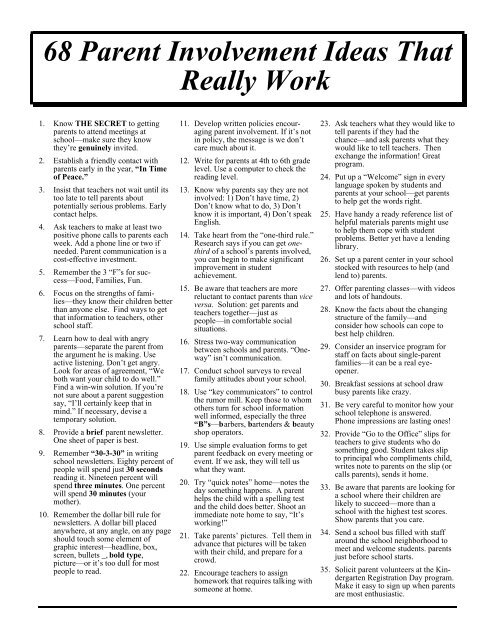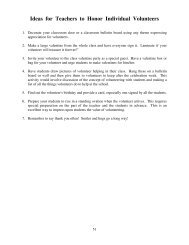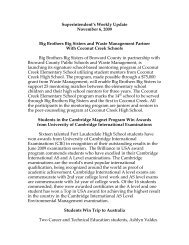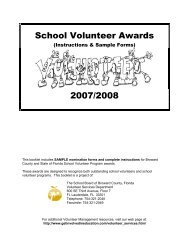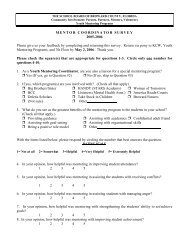68 Parent Involvement Ideas That Really Work - Get Involved
68 Parent Involvement Ideas That Really Work - Get Involved
68 Parent Involvement Ideas That Really Work - Get Involved
You also want an ePaper? Increase the reach of your titles
YUMPU automatically turns print PDFs into web optimized ePapers that Google loves.
<strong>68</strong> <strong>Parent</strong> <strong>Involvement</strong> <strong>Ideas</strong> <strong>That</strong><br />
<strong>Really</strong> <strong>Work</strong><br />
1. Know THE SECRET to getting<br />
parents to attend meetings at<br />
school—make sure they know<br />
they’re genuinely invited.<br />
2. Establish a friendly contact with<br />
parents early in the year, “In Time<br />
of Peace.”<br />
3. Insist that teachers not wait until its<br />
too late to tell parents about<br />
potentially serious problems. Early<br />
contact helps.<br />
4. Ask teachers to make at least two<br />
positive phone calls to parents each<br />
week. Add a phone line or two if<br />
needed. <strong>Parent</strong> communication is a<br />
cost-effective investment.<br />
5. Remember the 3 “F”s for success—Food,<br />
Families, Fun.<br />
6. Focus on the strengths of families—they<br />
know their children better<br />
than anyone else. Find ways to get<br />
that information to teachers, other<br />
school staff.<br />
7. Learn how to deal with angry<br />
parents—separate the parent from<br />
the argument he is making. Use<br />
active listening. Don’t get angry.<br />
Look for areas of agreement, “We<br />
both want your child to do well.”<br />
Find a win-win solution. If you’re<br />
not sure about a parent suggestion<br />
say, “I’ll certainly keep that in<br />
mind.” If necessary, devise a<br />
temporary solution.<br />
8. Provide a brief parent newsletter.<br />
One sheet of paper is best.<br />
9. Remember “30-3-30” in writing<br />
school newsletters. Eighty percent of<br />
people will spend just 30 seconds<br />
reading it. Nineteen percent will<br />
spend three minutes. One percent<br />
will spend 30 minutes (your<br />
mother).<br />
10. Remember the dollar bill rule for<br />
newsletters. A dollar bill placed<br />
anywhere, at any angle, on any page<br />
should touch some element of<br />
graphic interest—headline, box,<br />
screen, bullets _, bold type,<br />
picture—or it’s too dull for most<br />
people to read.<br />
11. Develop written policies encouraging<br />
parent involvement. If it’s not<br />
in policy, the message is we don’t<br />
care much about it.<br />
12. Write for parents at 4th to 6th grade<br />
level. Use a computer to check the<br />
reading level.<br />
13. Know why parents say they are not<br />
involved: 1) Don’t have time, 2)<br />
Don’t know what to do, 3) Don’t<br />
know it is important, 4) Don’t speak<br />
English.<br />
14. Take heart from the “one-third rule.”<br />
Research says if you can get onethird<br />
of a school’s parents involved,<br />
you can begin to make significant<br />
improvement in student<br />
achievement.<br />
15. Be aware that teachers are more<br />
reluctant to contact parents than vice<br />
versa. Solution: get parents and<br />
teachers together—just as<br />
people—in comfortable social<br />
situations.<br />
16. Stress two-way communication<br />
between schools and parents. “Oneway”<br />
isn’t communication.<br />
17. Conduct school surveys to reveal<br />
family attitudes about your school.<br />
18. Use “key communicators” to control<br />
the rumor mill. Keep those to whom<br />
others turn for school information<br />
well informed, especially the three<br />
“B”s—barbers, bartenders & beauty<br />
shop operators.<br />
19. Use simple evaluation forms to get<br />
parent feedback on every meeting or<br />
event. If we ask, they will tell us<br />
what they want.<br />
20. Try “quick notes” home—notes the<br />
day something happens. A parent<br />
helps the child with a spelling test<br />
and the child does better. Shoot an<br />
immediate note home to say, “It’s<br />
working!”<br />
21. Take parents’ pictures. Tell them in<br />
advance that pictures will be taken<br />
with their child, and prepare for a<br />
crowd.<br />
22. Encourage teachers to assign<br />
homework that requires talking with<br />
someone at home.<br />
23. Ask teachers what they would like to<br />
tell parents if they had the<br />
chance—and ask parents what they<br />
would like to tell teachers. Then<br />
exchange the information! Great<br />
program.<br />
24. Put up a “Welcome” sign in every<br />
language spoken by students and<br />
parents at your school—get parents<br />
to help get the words right.<br />
25. Have handy a ready reference list of<br />
helpful materials parents might use<br />
to help them cope with student<br />
problems. Better yet have a lending<br />
library.<br />
26. Set up a parent center in your school<br />
stocked with resources to help (and<br />
lend to) parents.<br />
27. Offer parenting classes—with videos<br />
and lots of handouts.<br />
28. Know the facts about the changing<br />
structure of the family—and<br />
consider how schools can cope to<br />
best help children.<br />
29. Consider an inservice program for<br />
staff on facts about single-parent<br />
families—it can be a real eyeopener.<br />
30. Breakfast sessions at school draw<br />
busy parents like crazy.<br />
31. Be very careful to monitor how your<br />
school telephone is answered.<br />
Phone impressions are lasting ones!<br />
32. Provide “Go to the Office” slips for<br />
teachers to give students who do<br />
something good. Student takes slip<br />
to principal who compliments child,<br />
writes note to parents on the slip (or<br />
calls parents), sends it home.<br />
33. Be aware that parents are looking for<br />
a school where their children are<br />
likely to succeed—more than a<br />
school with the highest test scores.<br />
Show parents that you care.<br />
34. Send a school bus filled with staff<br />
around the school neighborhood to<br />
meet and welcome students. parents<br />
just before school starts.<br />
35. Solicit parent volunteers at the Kindergarten<br />
Registration Day program.<br />
Make it easy to sign up when parents<br />
are most enthusiastic.<br />
Copyright © 1996 The <strong>Parent</strong> Institute
36. Don’t make judgments about<br />
parents’ lack of interest in their<br />
children’s education. You’ll<br />
probably be wrong. “Walk a mile in<br />
their shoes” and understand that what<br />
looks like apathy may be exhaustion.<br />
37. Try day-long parent academies with<br />
short repeated workshops on topics<br />
such as building self-esteem,<br />
language development, motivating<br />
children, encouraging reading,<br />
discipline, talking with kids about<br />
sex, dealing with divorce, etc. Test<br />
weekdays vs. weekends.<br />
38. Provide training and lots of school<br />
information for parent volunteers.<br />
They are powerful goodwill<br />
ambassadors.<br />
39. Invite parents to fill out interview<br />
forms detailing child’s special<br />
qualities—interests, abilities,<br />
accomplishments. Teachers can use<br />
information to write story about<br />
child to read at school program, post<br />
on bulletin board.<br />
40. Investigate “voice mail” systems to<br />
keep parents up-to-date on<br />
homework, school activities.<br />
41. Find ways to provide positive reinforcement<br />
to parents. Everyone<br />
responds well to recognition.<br />
42. Involve parents in goal-setting for<br />
their children. It promotes working<br />
as a team.<br />
43. Use research findings that one of the<br />
best ways to get parents involved is<br />
to simply ask them, and also tell<br />
them what you’d like them to do.<br />
44. Give parents specific suggestions<br />
about how they can help their<br />
children. Many just need to know<br />
things like: “Read aloud every day.”<br />
“Turn the TV off during homework<br />
time.”<br />
45. Try a short student-written<br />
newsletter for parents about what<br />
students have been learning. (You<br />
still need your own parent newsletter.<br />
You cannot fulfill your<br />
obligation to communicate by delegating<br />
the job to students.)<br />
46. Help parents understand why<br />
excessive TV hurts children—TV<br />
robs them of needed play, exercise,<br />
reading practice, study time, dulls<br />
critical thinking, encourages obesity<br />
through snacking.<br />
47. Understand the diversity of single<br />
parent families. Living with one<br />
parent can be wonderful for some<br />
children, destructive for others<br />
48. Offer school sponsored sessions on<br />
single parenting.<br />
49. Help parents understand that student<br />
effort is the most important key to<br />
school success, not just ability.<br />
50. Encouraging (and assisting) parents<br />
to network among themselves to<br />
solve common problems builds<br />
parent support.<br />
51. Provide some parent education<br />
classes at the workplace. Convenience<br />
works for 7-11 stores and it<br />
also works for schools.<br />
52. Try providing “Good News Postcards”<br />
for teachers to write short<br />
positive note about students and mail<br />
them home. One thousand postcards<br />
cost less than $200 to mail.<br />
53. Ask parents’ help in developing<br />
questions for a school “audit” to see<br />
if your school is family friendly.<br />
54. Invite parents to a program about<br />
helping children do well on<br />
homework and eliminating things<br />
that distract them. Most have never<br />
had such information.<br />
55. Ask parents to fill out a “Contact<br />
Sheet” listing home and work<br />
addresses and phone numbers—and<br />
the best times to be contacted in<br />
either place.<br />
56. Have children write personal notes<br />
to their parents on school papers,<br />
surveys, invitations to school<br />
programs, etc. Watch parent<br />
response rates soar!<br />
57. Help all school staff understand the<br />
central role they play in building<br />
parent attitudes, support and<br />
involvement—secretary, custodian,<br />
food service staff, bus driver,<br />
librarian, aides, everyone<br />
58. Try sending home “Resource Bags”<br />
filled with games, videos, reading<br />
materials and instructions on specific<br />
activities parents can do with<br />
children at home. They’re very<br />
popular.<br />
59. Having problems getting parents<br />
involved with a child who’s having<br />
discipline or other problems? Try<br />
videotaping class sessions. Showing<br />
the “candid camera” tape to parents<br />
and children works wonders.<br />
60. Make sure all staff know the top<br />
things parents report they want to<br />
know about school: 1) How they can<br />
be involved with their child’s<br />
education, 2) How they can spend<br />
more time at school, 3) How to talk<br />
to teachers, other school staff, 4)<br />
How to help their child at home.<br />
61. Try holding “non-academic” social<br />
events to draw parents to school to<br />
see students’ work.<br />
62. Try an evening Curriculum Fair to<br />
give parents a better understanding<br />
of what’s being taught.<br />
63. Try a “Family Math Night” to<br />
inform parents about the math<br />
curriculum through math games.<br />
64. Try “refrigerator notes.” Ask students<br />
to “Take this note home and<br />
put it in the refrigerator.” <strong>That</strong> gets<br />
attention!<br />
65. Know that parents are also looking<br />
to schools for help in dealing with<br />
non-academic problems (child care,<br />
raising adolescents, advice on drugs,<br />
sexual activity). Providing help can<br />
build parent support.<br />
66. Understand one key reason for<br />
parent non-involvement: Lack of<br />
information. One memo won’t do.<br />
Try letters & notes & signs & calls<br />
& newspaper & radio & TV. Repetition<br />
works & works & works.<br />
67. Transition Nights (or days, or<br />
afternoons) for parents and students<br />
getting ready to go to a new school<br />
help answer questions, relieve<br />
anxieties, build involvement and<br />
support.<br />
<strong>68</strong>. Want to get parents out for school<br />
meetings? Make children welcome<br />
by offering child care.<br />
—These ideas from a presentation by John H. Wherry,<br />
Ed.D., President, The <strong>Parent</strong> Institute, P.O. Box 7474,<br />
Fairfax Station, VA 22039-7474. The <strong>Parent</strong> Institute publishes<br />
the Educators’ Notebook on Family <strong>Involvement</strong><br />
newsletter for school staff (from which all ideas for this<br />
handout have been taken), the <strong>Parent</strong>s Make the<br />
Difference! newsletter for schools to distribute to parents<br />
of elementary grade children, the <strong>Parent</strong>s STILL Make the<br />
Difference! newsletter for parents of secondary school<br />
children, as well as booklets and videos for parents. For<br />
information about publications and services call toll-free:<br />
1-800-756-5525. Copyright © 1996, The <strong>Parent</strong> Institute.<br />
Permission granted for reproduction of this material if this<br />
credit message is included.<br />
Copyright © 1996 The <strong>Parent</strong> Institute


